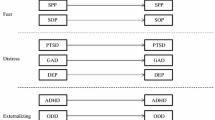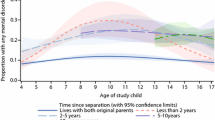Abstract.
Objective: The aim of this study was to asses whether children and their parents identify the same risk factors for disruptive and depressive disorders and to analyze whether combining informant data with a rule that classifies the diagnosis as present if confirmed by at least one informant (OR rule) masks distinctive patterns identified in informant-specific analyses. Method: Bivariate logistic regression equations were estimated using the diagnostic classification, based on DISC 2.1, as the outcome variable and informant (parent or child), characteristics of the youth (gender and age), indicators of the context of the interview (site), and family characteristics (income, parental monitoring, and adverse family environment) as predictors. The same predictors were also analyzed with the combined informant (OR rule) as outcome variable. Results: Prevalence of all diagnoses varied with informant. Depressive disorders were more prevalent when the informant was the youth and disruptive disorders when the informant was the parent. The effect of age varied with informant. Odds of being classified as having a DISC disorder increased with age when the informant was the youth but the same effect was not observed when the parent was the informant. When information from parents and youth are combined (with an OR rule) the age effect for disruptive disorders vanishes, and its effect for depressive disorders weakens. Conclusions: Informants are not interchangeable. Parent- and youth-based estimates of the prevalence of disruptive and depressive disorders were different and showed distinctive age relationships. Combining information from different sources (parents and youths) obscures the apparent effect of age noted in the two informant groups.
Similar content being viewed by others
Author information
Authors and Affiliations
Additional information
Received: 5 September 2001 / Accepted: 8 August 2002
Dr. Garrett Fitzmaurice was funded in part by NIMH grant RO1-MH54693.
Correspondence to Prof. Maritza Rubio-Stipec, Ph.D.
Rights and permissions
About this article
Cite this article
Rubio-Stipec, M., Fitzmaurice, G., Murphy, J. et al. The use of multiple informants in identifying the risk factors of depressive and disruptive disorders . Soc Psychiatry Psychiatr Epidemiol 38, 51–58 (2003). https://doi.org/10.1007/s00127-003-0600-0
Issue Date:
DOI: https://doi.org/10.1007/s00127-003-0600-0




